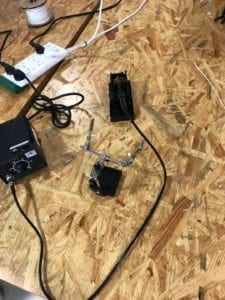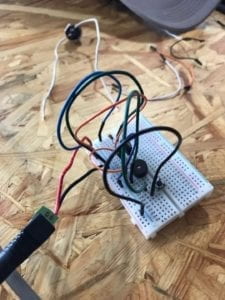Recitation
In this week’s recitation, we had to solder and build circuits on a breadboard. Before building the circuits, we first had a soldering workshop to solder long wires to an arcade button. First, my partner Hangkai and I had to cut out the surface of electric wires to reveal the inner core with special gear-shaped scissors, during which we encountered a problem. We often cut off the whole wire, but luckily an assistant told us the trick — put the wire at a U-shaped gap and only the wire surface gets cut off. Then we clipped the cut wire. When soldering, first heat up the soldering tool, then add iron wire to where the button and the electric wire connected and wait for melted iron to cool down. In this process, I accidentally heated the plastic part of the button and it gave off putrid smells. I also noticed the importance of safety when handling these tools.

Now that soldering is accomplished, next we move on to building the circuits. At first, my partner and I tried to build the circuit without a breadboard, but the wires were too intertwined. Fortunately, a helpful IMA fellow helped us understand how to use the breadboard. However, sometimes the iron wires were bent too much and we had to get new ones. Another problem was the tremendous difference between a unit on the graph and in real life. Finally, circuit 1 was built, as well as the two others. In the video below you can hear the clicking sounds of the doorbell. Unfortunately, we ran out of time and only completed the first circuit.

Questions
Question 1: After reading The Art of Interactive Design, I concluded that interactivity in the circuits we built was the human and non-human communication. When pressing the button, the doorbell rang, which was a form of response to human’s work in building the machine (suppose it was one).
Question 2: After watching Zach Lieberman’s video, I concluded that interaction design and physical computing could be used to create interactive art in this way: Art is immobile, but physical computing can make it mobile and interact with humans. For example, he mentioned the project “drawn” where drawings could move with human gestures.